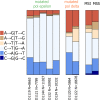Human mismatch repair system balances mutation rates between strands by removing more mismatches from the lagging strand
- PMID: 28512192
- PMCID: PMC5538550
- DOI: 10.1101/gr.219915.116
Human mismatch repair system balances mutation rates between strands by removing more mismatches from the lagging strand
Abstract
Mismatch repair (MMR) is one of the main systems maintaining fidelity of replication. Differences in correction of errors produced during replication of the leading and the lagging DNA strands were reported in yeast and in human cancers, but the causes of these differences remain unclear. Here, we analyze data on human cancers with somatic mutations in two of the major DNA polymerases, delta and epsilon, that replicate the genome. We show that these cancers demonstrate a substantial asymmetry of the mutations between the leading and the lagging strands. The direction of this asymmetry is the opposite between cancers with mutated polymerases delta and epsilon, consistent with the role of these polymerases in replication of the lagging and the leading strands in human cells, respectively. Moreover, the direction of strand asymmetry observed in cancers with mutated polymerase delta is similar to that observed in MMR-deficient cancers. Together, these data indicate that polymerase delta (possibly together with polymerase alpha) contributes more mismatches during replication than its leading-strand counterpart, polymerase epsilon; that most of these mismatches are repaired by the MMR system; and that MMR repairs about three times more mismatches produced in cells during lagging strand replication compared with the leading strand.
© 2017 Andrianova et al.; Published by Cold Spring Harbor Laboratory Press.
Figures






Similar articles
-
Mismatch repair balances leading and lagging strand DNA replication fidelity.PLoS Genet. 2012;8(10):e1003016. doi: 10.1371/journal.pgen.1003016. Epub 2012 Oct 11. PLoS Genet. 2012. PMID: 23071460 Free PMC article.
-
Evidence from mutational specificity studies that yeast DNA polymerases delta and epsilon replicate different DNA strands at an intracellular replication fork.J Mol Biol. 2000 Jun 2;299(2):405-19. doi: 10.1006/jmbi.2000.3744. J Mol Biol. 2000. PMID: 10860748
-
Mismatch repair and DNA polymerase δ proofreading prevent catastrophic accumulation of leading strand errors in cells expressing a cancer-associated DNA polymerase ϵ variant.Nucleic Acids Res. 2020 Sep 18;48(16):9124-9134. doi: 10.1093/nar/gkaa633. Nucleic Acids Res. 2020. PMID: 32756902 Free PMC article.
-
Eukaryotic Mismatch Repair in Relation to DNA Replication.Annu Rev Genet. 2015;49:291-313. doi: 10.1146/annurev-genet-112414-054722. Annu Rev Genet. 2015. PMID: 26436461 Free PMC article. Review.
-
Balancing eukaryotic replication asymmetry with replication fidelity.Curr Opin Chem Biol. 2011 Oct;15(5):620-6. doi: 10.1016/j.cbpa.2011.07.025. Epub 2011 Aug 19. Curr Opin Chem Biol. 2011. PMID: 21862387 Free PMC article. Review.
Cited by
-
Cell-type specificity of the human mutation landscape with respect to DNA replication dynamics.Cell Genom. 2023 May 2;3(6):100315. doi: 10.1016/j.xgen.2023.100315. eCollection 2023 Jun 14. Cell Genom. 2023. PMID: 37388911 Free PMC article.
-
Genome-wide measurement of DNA replication fork directionality and quantification of DNA replication initiation and termination with Okazaki fragment sequencing.Nat Protoc. 2023 Apr;18(4):1260-1295. doi: 10.1038/s41596-022-00793-5. Epub 2023 Jan 18. Nat Protoc. 2023. PMID: 36653528 Review.
-
Distinct mutational signatures characterize concurrent loss of polymerase proofreading and mismatch repair.Nat Commun. 2018 May 1;9(1):1746. doi: 10.1038/s41467-018-04002-4. Nat Commun. 2018. PMID: 29717118 Free PMC article.
-
Stability across the Whole Nuclear Genome in the Presence and Absence of DNA Mismatch Repair.Cells. 2021 May 17;10(5):1224. doi: 10.3390/cells10051224. Cells. 2021. PMID: 34067668 Free PMC article. Review.
-
Mutational Signatures in Wild Type Escherichia coli Strains Reveal Predominance of DNA Polymerase Errors.Genome Biol Evol. 2024 Apr 2;16(4):evae035. doi: 10.1093/gbe/evae035. Genome Biol Evol. 2024. PMID: 38401265 Free PMC article.
References
-
- Chen C-L, Duquenne L, Audit B, Guilbaud G, Rappailles A, Baker A, Huvet M, d'Aubenton-Carafa Y, Hyrien O, Arneodo A, et al. 2011. Replication-associated mutational asymmetry in the human genome. Mol Biol Evol 28: 2327–2337. - PubMed
MeSH terms
Substances
LinkOut - more resources
Full Text Sources
Other Literature Sources
